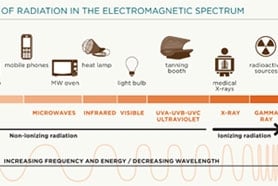
Electromagnetic fields (EMF) are areas of energy radiating from natural and human-made sources. But how do these omnipresent EMFs affect your health?
Invisible, yet omnipresent forces are continuously trespassing in our surroundings. They are not ghosts, but rather electromagnetic fields from natural and man-made sources. Could our daily exposure to this radiation cause health problems?
What are electromagnetic fields?
Electromagnetic fields (EMF) are areas of energy radiating from natural and human-made sources. Their energy (EM radiation) self-propagates in waves through most materials at the speed of light. EM waves have crests and troughs like ocean waves.
Wavelength is the distance between crests.
Frequency is the number of crests passing a given point within one second.
EM radiations differ from one another in their wavelength and frequency. Collectively, they form the electromagnetic spectrum (see figure below).

(click to enlarge)
Wavelength and frequency are inseparably intertwined: the higher the frequency, the shorter the wavelength, and vice versa.
Non-ionizing radiation
(also called non-penetrating radiation)
- low-frequency waves with enough energy to move around atoms in a molecule or cause them to vibrate, but not enough to remove electrons
- do not pass through the skin but can still cause damage
Ionizing radiation
(also called penetrating radiation)
- high-frequency waves with enough energy to remove tightly bound electrons from atoms, creating ions
- can enter the body and damage or destroy living cells
Non-ionizing radiation—man-made sources
Radio frequency (RF) radiation
Main sources:
- communications devices (radio and television, wireless technologies, and computer networks)
- electrical appliances and the power lines feeding those devices
In industrialized societies, we are particularly and chronically exposed to low-energy RF (extremely low frequencies or ELF).
Health effects:
According to the World Health Organization (WHO), the only health effect caused by any RF field is the increase in body temperature (>1 C) from overexposures at very high field intensity found only in certain industrial facilities.
The levels of RF exposure from base stations and wireless networks are considered insignificant, with no confirmed effect on human health.
Yet the data for long-term low-level exposure remains limited. For instance, studies on cancer risks from mobile phone radiation cannot be considered reliable, since many cancers take more than 20 years to develop.
Unfortunately, any long-term health effect from RF radiation will be shown by future studies on today’s children and adolescents, who will experience a much higher cumulative exposure than previous generations.
Microwave (MW) emission
Main sources:
- TV broadcasting
- radars
- telecommunications, including mobile phones
- in industry for processing
- in medicine for diathermy treatment
- in kitchens for heating/cooking food
Health effects:
Similar to RF, intense exposures to MW rays (much more than the limit for microwave oven leakage) damage tissues through heating. MW could also cause cataracts and temporary sterility at high levels of radiation frequency and dose.
Infrared (IR) wave
Main sources:
- furnaces
- heat lamps
- IR saunas
- IR security light detectors
- short-range communication devices
Health effects:
Overexposure to IR rays can lead to overheating, burns, eye damage, and dehydration.
Visible light
Its main artificial source is an incandescent light bulb. Usually visible light is not harmful, but severe eye damage could occur if it is too intense.
Ultraviolet (UV) radiation
Main sources:
Artificial sources of UV light are used in
- germicidal lamps
- energy-efficient compact fluorescent lamps
- tanning booths
- phototherapy to treat several diseases, including psoriasis and eczema
The UV region is divided into three bands:
- UVA (long wave UV)
- UVB (middle wave UV)
- UVC (shortwave UV)
All UVC and approximately 90 percent of UVB radiation is absorbed by the ozone layer.
Health effects:
Prolonged human exposure to any type of UV radiation may result in acute and chronic health effects on the skin, eyes, and immune system. Ultimately, UV radiation induces premature skin aging, skin cancer, and cataracts.
Consumer awareness
- Increase the distance between you and EMF sources.
- Reduce the amount of time close to EMF sources.
- Minimize your exposure to medical X-rays.
- Follow guidelines for safe equipment operation.
- Obtain accurate and authoritative information.
Ionizing radiation—man-made sources
X-ray radiation
Main sources:
X-rays are capable of penetrating solid objects, which makes them useful in
- airport security checks to see inside luggage and humans (full-body scanners)
- diagnostic medical procedures (to spot broken bones and dental problems, and to locate and identify tumours)
- therapeutic medical procedures (to kill cancerous tissue, reduce the size of a tumour, or reduce pain)
Health effects:
Cumulative exposures to X-rays increase the risk of cancer and developmental defects, so children and teenagers are especially vulnerable to them.
Gamma radiation
Gamma rays are released by radioactive substances. They are extremely high-frequency waves that can pass through most materials and carry more energy than the rest.
Main sources:
- diagnose and treat cancer and other diseases
- sterilize medical equipment
- irradiate many types of food
- produce electricity (by nuclear power plants)
Health effects:
Overexposure to gamma rays can cause DNA mutations, cell damage, and a variety of cancers.
Governmental and scientific positions
Health Canada is part of an ongoing International EMF Project, coordinated by WHO. The goals of this project are to verify reported biological effects from exposure to EMF, particularly widespread RF, and to characterize any associated health risks to humans.
Although no adverse health effects have been demonstrated, the researchers considered that there are gaps in knowledge requiring further investigation.
Areas of uncertainty include:
- understanding how EMFs could cause cancer
- the type of exposure that might be important (short periods of exposure to high levels or long periods of exposure to low levels)
- not enough evidence in experiments with animals
Can we escape the EMF world?
Weak natural EM fields from the Earth and cosmic sources are an integral part of life. In contrast, EM fields from man-made devices and systems in our industrialized societies are typically far above levels of the natural background radiation.
Just in the last 30 years our exposure to electromagnetic radiation from radio waves and microwaves alone has increased millions of times relative to the natural levels. This trend is likely to continue because of the exponential increase in the use of devices and systems employing EM energy in the workplace, in the home, and in external environments.
Are current safety standards protecting us?
Most of us are exposed daily to many sources of non-ionizing ELF magnetic fields at home and in the workplace. Their toxicological effects are difficult to determine. Available data indicate their strength is hundreds of times below the international limit for the general public and do not seem to currently pose health risks.
Less common is our exposure to man-made ionizing radiations from medical procedures and industrial applications, and even more rarely from nuclear plant accidents. The effects of these ionizing radiations are well known, including the increased risk of cancer.
These types of radiation are generally carefully controlled and directed to avoid damaging effects on humans and the environment.
The existing standards and guidelines reflect the current state of scientific knowledge in this field. They will continue changing along with the acquisition of more adequate and reliable data on EMF short- and long-term exposure risks.



